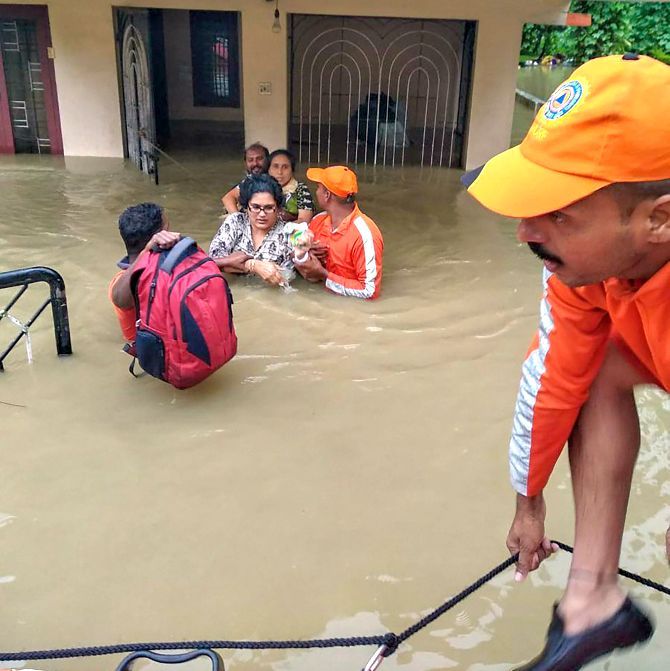'In 1924 (it was the year 1099 in the Malayalam calendar), the deluge came even as the state was dealing with the ailing health and eventual death of the reformist maharaja of Travancore, Mulam Thirunal.'
'The next in line was Sree Chithira Thirunal.'
'He was only 11 at the time.'
'The kingdom’s administration moved into the hands of his aunt, Sethu Lakshmi Bayi, who ruled as regent, assisted by Dewan T Raghavaiah.'
'The calamity they faced was dire.'
Sachin P Mampatta goes back in time to recall a deluge that that has passed into lore in Kerala.

Historians claim, in 1924, the hills came down to the valleys in Munnar, Kerala.
After the floods this year, the situation is not too different.
In 1924, the deluge came even as the state was dealing with the ailing health and eventual death of the reformist maharaja of Travancore, Mulam Thirunal.
The next in line was Sree Chithira Thirunal.
He was only 11 at the time.
The kingdom’s administration moved into the hands of his aunt, Sethu Lakshmi Bayi, who ruled as regent, assisted by Dewan T Raghavaiah.
The calamity they faced was dire.
In his book on the Travancore kingdom, Ivory Throne, Manu S Pillai quotes from the Mannar flood relief deputation report: 'Five hundred houses, 200 coconut gardens, 1,000 acres of land, and 640,000 kilograms of grain had been lost in the vicinity of… one central Travancore hamlet alone.'
This is just one of the several hundred accounts from the Flood of ’99 -- 1924 was 1099 in the Malayalam calendar -- that has passed into lore in Kerala.
This year, as the southern state faces another such deluge, the memories have also come alive.
'The roads were breached at all places and many bridges were washed away. In fact, in all places affected by the flood, the elements were seen to be at war with man and he has no dry earth to stand on, no good water to drink and no fire to cook,' according to a contemporary government report, quoted in a paper, A Travancore Model in Disaster Management: Ducebat Viam for the Current Times, by Sebastian Joseph, assistant professor, Union Christian College, Aluva, and Lekha Pillai, assistant professor, NSS College, Pandalam.
In 1924, initial rescue efforts were stymied by a second round of flooding.
Relief operations were affected and co-ordination was difficult because of the limited communication technology available at the time.
According to different accounts, the government utilised the telegraph services and partnered local committees to better deal with the situation.
A lot of the relief work was also done by different institutions -- private, public, and religious -- coming together remarkably, said Lekha Pillai.
The government announced agricultural loans to the tune of Rs 550,000 at an interest rate of 6.25 per cent.
The rate was reduced to 6 per cent on the order of the regent.
Historians have found that each person was given a maximum loan of Rs 500.
This was nearly five times the per capita income in the country.
Similar amounts were allocated to the public works department to repair roads and infrastructure that had been destroyed.
Some of it could never be reconstructed.
An example was the Kundala Valley railway system.
It was a monorail that had become a light railway system by 1908.
The flood destroyed it completely, and it never recovered.
Whatever remained disappeared during the Second World War, according to the Tata Central Archives Newsletter (January 2006).
During his budget speech this year, Kerala finance minister T M Thomas Isaac had made a reference to the 1924 flood.
“Climate change opens up challenges of even unheard of disasters… We must take all precautions for meeting these. The largest natural calamity recorded in the history of modern Kerala was the Flood of ’99… the Travancore government had taken immediate measures and formulated long-term policies in this regard,” he said.
Among the Travancore government’s long-term measures were the creation of canals, which could absorb rising water levels to reduce the intensity of floods.
Isaac spoke of the need for similar long-term disaster-management plans in February.
In August, Kerala was inundated, receiving 42 per cent excess rainfall.
The government has also resisted the preservation of bio-diversity on the Western Ghats.
“The embargo on new hydro-electric projects and the conditions imposed on them are unacceptable to Kerala, Maharashtra, and Tamil Nadu,” noted the report of the high-level working group on the Western Ghats, chaired by Planning Commission member K Kasturirangan.
According to news reports, the previous -- and stricter -- Madhav Gadgil committee report was even more unacceptable to the states.











